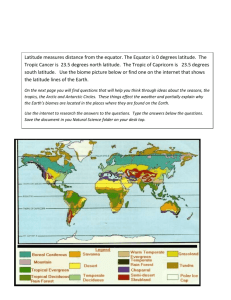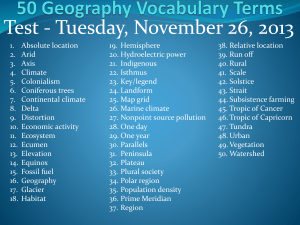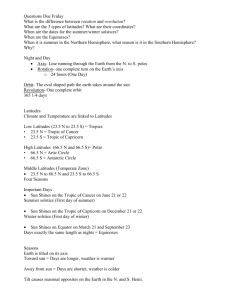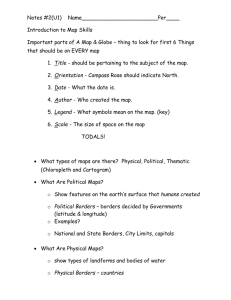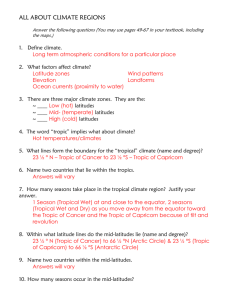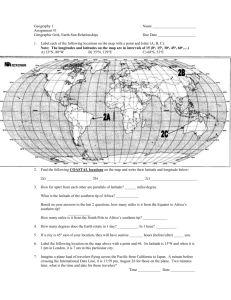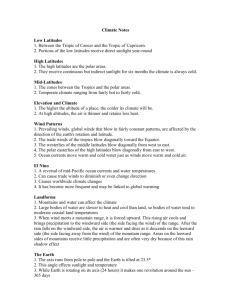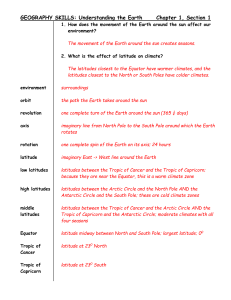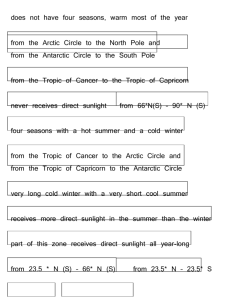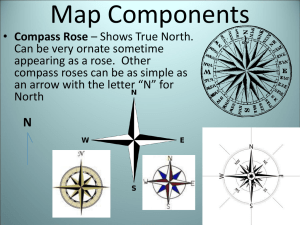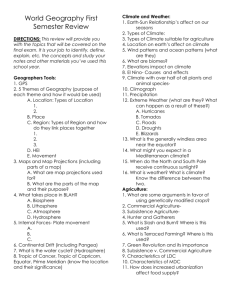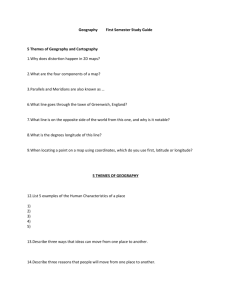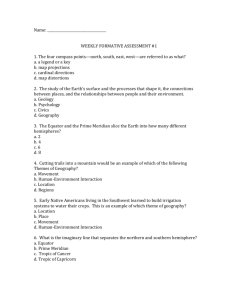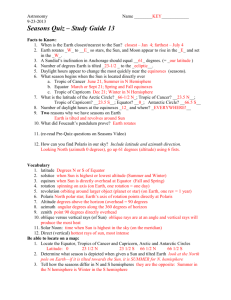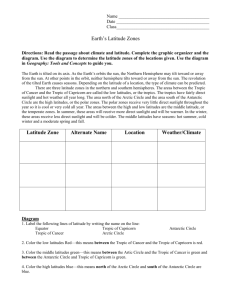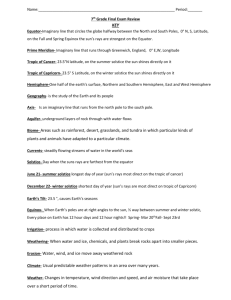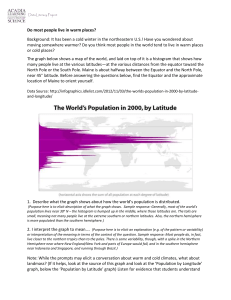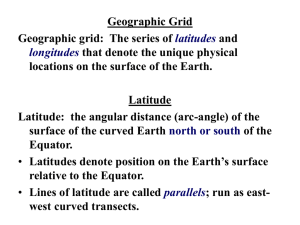Weather and Climate
advertisement
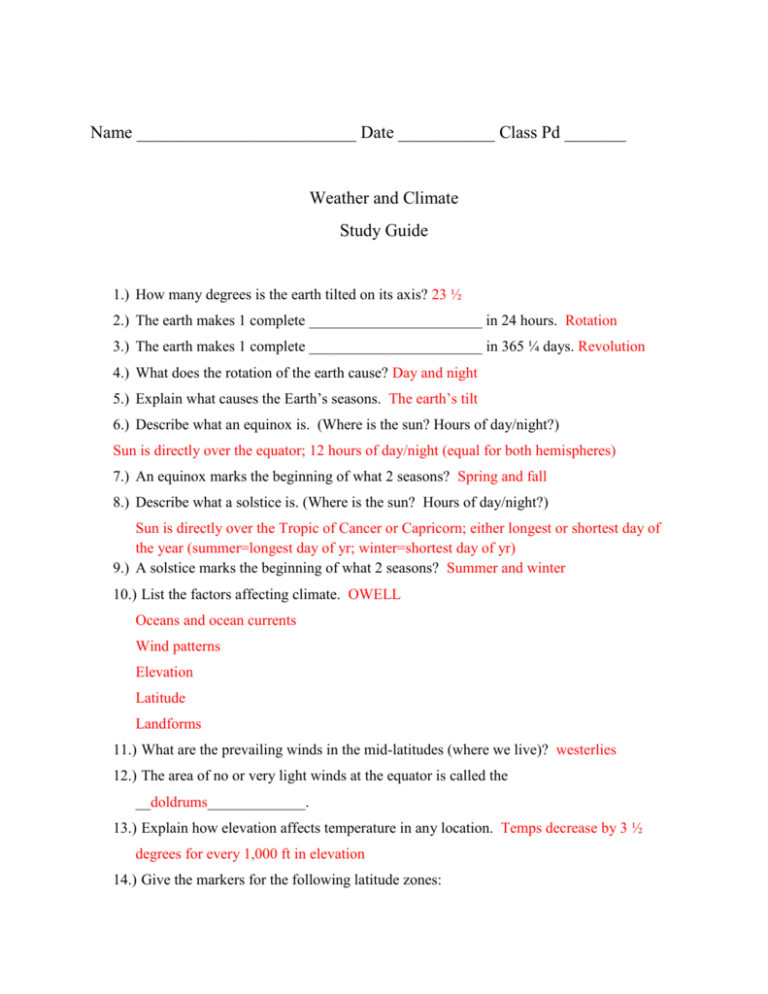
Name _________________________ Date ___________ Class Pd _______ Weather and Climate Study Guide 1.) How many degrees is the earth tilted on its axis? 23 ½ 2.) The earth makes 1 complete _______________________ in 24 hours. Rotation 3.) The earth makes 1 complete _______________________ in 365 ¼ days. Revolution 4.) What does the rotation of the earth cause? Day and night 5.) Explain what causes the Earth’s seasons. The earth’s tilt 6.) Describe what an equinox is. (Where is the sun? Hours of day/night?) Sun is directly over the equator; 12 hours of day/night (equal for both hemispheres) 7.) An equinox marks the beginning of what 2 seasons? Spring and fall 8.) Describe what a solstice is. (Where is the sun? Hours of day/night?) Sun is directly over the Tropic of Cancer or Capricorn; either longest or shortest day of the year (summer=longest day of yr; winter=shortest day of yr) 9.) A solstice marks the beginning of what 2 seasons? Summer and winter 10.) List the factors affecting climate. OWELL Oceans and ocean currents Wind patterns Elevation Latitude Landforms 11.) What are the prevailing winds in the mid-latitudes (where we live)? westerlies 12.) The area of no or very light winds at the equator is called the __doldrums_____________. 13.) Explain how elevation affects temperature in any location. Temps decrease by 3 ½ degrees for every 1,000 ft in elevation 14.) Give the markers for the following latitude zones: a.) Low latitudes: 23 ½ degrees N to 23 ½ degrees S b.) Mid latitudes: 23 ½ degrees to 66 ½ degrees N and S c.) High latitudes: 66 ½ degrees to 90 degrees N and S 15.) The low latitudes are also called the ____tropics____________ because they are located between the Tropic of Cancer and Tropic of Capricorn. This latitude zone is __warm____ year-round because it receives the direct rays of the sun. 16.) For each line of latitude, write the degrees: a.) Equator 0 degrees latitude b.) North Pole 90 degrees N c.) South Pole 90 degrees S d.) Tropic of Cancer 23 ½ degrees N e.) Tropic of Capricorn 23 ½ degrees S f.) Arctic Circle 66 ½ degrees N g.) Antarctic Circle 66 ½ degrees S 17.) Explain what the orographic (rain shadow) effect is. (You may draw a diagram) Moisture-bearing winds dry out as they rise over mountains. Rain falls on the windward side, but the leeward side is often dry, sometimes causing a desert on that side of the mountain. 18.) Contrast windward/leeward- windward side of mountain is wet; leeward side of mountain is dry 19.) Contrast weather/climate- weather: temporary conditions of the atmosphere; climate: expected weather patterns for a location 20.) Explain why Northwestern Europe is not as cold as Canada even though they are approximately at the same high latitude. Because NW Europe is warmed by a warm ocean current – the Gulf Stream. 21.) A climagraph provides what 2 types of information about a location? Precipitation and temperature 22.) This type of climate is found along the equator. Temperatures and rainfall are steadily high year-round. ________tropical humid (rainforest)_______________ 23.) This type of climate might receive between 10 and 20 inches of rainfall per year. It has short grasses and not many trees. It is considered a transition between deserts and more humid climates. _______semiarid or steppe___________________ 24.) The Northwestern coast of the U.S. and most of Western Europe has this type of climate, known for its cool rainy winters. ________marine west coast___________________ 25.) ___Desert (arid)___________ climates are usually found around 30 degrees latitude and receive less than 10 inches of rain per year. Use the climagraph below to answer the following questions. 26.) What is the rainiest month in Moscow? How much rain falls in that month? July; 3.5 inches 27.) What is the coldest month in Moscow? What is that month’s average temperature? January; 9 degrees 28.) What climate zone do you think Moscow is in? a. tropical rainforest b. subarctic c. desert
